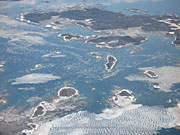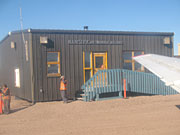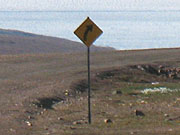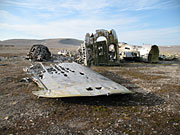Keith Cowing’s Devon Island Journal – 11 July 2007: Heading North
Our flight today from Ottawa to Resolute Bay began with a little drama. Last night when Matt Reyes flew from Las Vegas to Philadelphia to Ottawa his luggage did not keep up with him. His tent and all of the gear he’d need for the arctic was somewhere in limbo. After multiple phone calls last night and more this morning we were more or less resigned to making the trip up with the hope that his luggage would soon catch up with him.
Then, at the last minute, someone from First Air (the airline we were getting on) came running to the gate with the news that his stuff had been found. With that good news we hoped on our initial flight from Ottawa to Iqualuit.
We met the group of K10 rover operators heading up to Devon Island from the Intelligent Robotics Group at NASA Ames Research Center. They were just as sleep deprived as Matt and I were.
The first leg of what would eventually be a 10-hour trip was rather uneventful – not unlike any medium range commuter flight I have taken dozens of times. Sleeping made it even shorter.
I went to sleep flying over forests. I awoke flying over ice and barren ground. Ah, the arctic!
We had two-hour layover in Iqualuit. With nothing else to do, Matt and I went out for a walk toward downtown Iqualuit. Given the uncertainty about boarding times, we did not stray too far. At one point I was actually able to use my cell phone to call home. That was a surprise. The last time I was here (in 2003) you had to wait in line to use one of the two pay phones inside the terminal. Progress.
Eventually we boarded a more cramped Hawker Siddeley HS-748 turboprop (built in the late 1950’s) for the trip that would eventually drop us at Resolute Bay. Matt and I were soon glad that we both had the Bose noise canceling headphones. Without them our brains would have been turned to mush.
On the way we stopped for fuel at Hall Beach and Nanisivik. Both are small communities with a very small population and a large gravel runway. Give the dryness and good weather, our plane’s tires really created a torrent of dust and gravel as we took off.
While we refueled at Hall Beach we stood around looking at the scenery. There isn’t much – with the exception of two huge, old, Distant Early Warning (DEW) radar installations. These radar systems were established back in the 1950’s and were the reason why Hall Beach was created. Now they are abandoned.
Later, when we landed at Nanisivik, there was much more to look at. Perched up on a rise above the town and the bay we got a nice vista to look at while our plane was being refueled. Nanisivik was founded to service a large lead mine nearby. Now, that mine is being shut down the town is apparently going away as well.
The funniest thing I saw was a lone traffic sign warning of a winding road heading away from the landing strip. It was odd to see this since you could clearly see the road winding away. Yet there were no signs warning vehicular traffic of incoming airplanes.
Soon enough we were in the air again for the hour or so trip to Cornwallis Island – and Resolute Bay. Eventually, we began our descent into Resolute airport.
As we were heading in, Matt picked up a map on the back of the airline magazine and pointed to the large island to our right.
“Is that …?” he asked
“Yes, That’s Devon”. I answered. A large grin appeared on Matt’s face.
We landed without incident and departed the plane. After a short walk to Resolute Airport’s one gate terminal we were greeted by Haughton-Mars Project Principal Investigator Pascal Lee and his dog “Ping Pong”.
After our luggage appeared we stopped off at the Polar Continental Shelf Project Facility. This facility is run by the Canadian government organization that runs logistics that supports our project and others around the Canadian arctic.
We needed to drop off any luggage here at PCSP that we would not need overnight so as to simplify cargo loading tomorrow morning. Since I was going to be part of the first team of four going over tomorrow morning I left most of my stuff behind.
We then headed for the Tadjaat Co-op Hotel – Qausuittuq Inns North. The Co-op is a classic example of permafrost construction – everything is up off of the ground – and all surfaces are heavily insulated. Every room is nice and comfortable with curtains that are designed to block 95% of the outside sunlight. Usually you stay two to a room. The place is empty right now so we each got our own room.
After dinner at the Co-op, Pascal took us on a tour of the major attractions in Resolute. We saw a dog team in training, wreckage from a plane crash decades ago, a fascinating Inuit settlement that is being restored – complete with whalebone beams (which were once covered by animal hides)
When we returned we took a tour of downtown Resolute Bay (population 200). The downtown tour takes about 3 minutes – 6 minutes if you turn around and drive back through town.
After doing some website updates in my room, I went to sleep around midnight local time. Of course, were it not for the thick curtains in my room, I’d be bombarded with bright sunlight. Not that this mattered since I would have still fallen asleep quickly. More on that in a day or so when I am on Devon Island.
About Devon Island, The Haughton-Mars Project, and the Mars Institute
The Haughton-Mars Project (HMP) is an international interdisciplinary field research project centered on the scientific study of the Haughton impact structure and surrounding terrain, Devon Island, high arctic, viewed as a terrestrial analog for Mars. The rocky polar desert setting, geologic features and biological attributes of the site offer unique insights into the possible evolution of Mars – in particular the history of water and of past climates on Mars, the effects of impacts on Earth and on other planets, and the possibilities and limits of life in extreme environments. In parallel with its science program, the HMP supports an exploration program aimed at developing new technologies, strategies, humans factors experience, and field-based operational know-how key to planning the future exploration of the Moon, Mars and other planets by robots and humans. The HMP managed jointly by the Mars Instituteand by the SETI Institute.
Keith Cowing’s 2007 Devon Island Journals
10 July 2007: Back to the Arctic
11 July 2007: Heading North
12 July 2007: Dropping Onto Devon Island
13 July 2007: Teaching About Roses on Mars
14 July 2007: Using an iPhone on Mars
15 July 2007: Surreal Landscapes and Late Evening Thoughts
16-17 July 2007: Webcasts, Robots, Astronauts, and Dogs
18 July 2007: Ancient Memorials for Modern Space Explorers
19 July 2007: Sheer Audacity
20-22 July 2007: The Persistence of Memory
27 July 2007: Polar Deserts and Global TV
Keith Cowing’s 2003 Devon Island Journals
17 Jun 2003: Preface: Moving from Green to Grey
3 Jul 2003: Waiting in Resolute
3-5 July 2003: Arrival and Getting to Work
6 July 2003: Getting in the Groove
7 July 2003: Part 1: Being here – and being there.
7 July 2003: Part 2: Getting Out of Base Camp
8 July 2003: Infrastructure
9 July 2003: Re-connected; Planting Seeds
17 July 2003: Rover Arrival
18 July 2003: Wind
19 July 2003: Illness, Good Food, and Morale
20 July 2003: Arctic Memorials and Starship Yearnings
20 July 2003: Going Home
21 July 2003: Departure – and One Last Dedication
24 July 2003: 24 July 2003: Homeward Bound – In Slow Motion
26 August 2003: Home +30
Keith Cowing’s 2002 Devon Island Journals
8 Jul 2002: Arrival
9 Jul 2002: Getting acquainted – and down to work
10 Jul 2002: Mars carpentry
11 Jul 2002: Lexan Kites, shotguns, and Driver’s Ed
12 Jul 2002: Building and exploring
13-15 Jul 2002: Building a Mars greenhouse on Earth
16 Jul 2002: Sealing Greenhouses on Earth – and Mars; 6 Wheeled Rovers
17 Jul 2002: Greenhouse Dedication, Fishing, and Mystery Food
18 Jul 2002: Giving Blood, Eternal Light, and an Evening Commute
19 Jul 2002: The Hottest Place on Devon Island, T-shirts, a Star Trek hello
20 Jul 2002: Mars Airplanes and Communicating With Earth
21 Jul 2002: Visiting ministers, missing ‘green’, and crater tours
22 Jul 2002: The hottest place on Devon Island
23 Jul 2002: Farewells, Birthdays, and Bartering
24 Jul 2002: EVAs, movies – and ‘being here’
25 Jul 2002: Russian TV, webcam privacy, and being on Mars for a few minutes
26 Jul 2002: Cold Feet, Chocolate, and Home Cooking
27 Jul 2002: Anchors and anemometers
28 Jul 2002: Drilling into permafrost; leaving footprints for eternity
29 Jul 2002: Showering near the North Pole; one last look around
30 Jul 2002: Departure and arrival
31 Jul 2002: Culture shock and flight delays
1 Aug 2002: Departure into darkness
2 Aug 2002: Green overdose; home at last
2 Sep 2002: Home +30





























